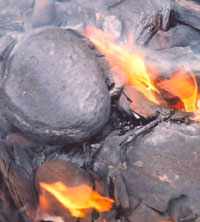| Sedimentary rock | |
 Combustion of oil shale | |
| Composition | |
|---|---|
| Primary | |
| Secondary | |
Oil shale is an organic-rich fine-grained sedimentary rock containing kerogen (a solid mixture of organic chemical compounds) from which liquid hydrocarbons can be produced. In addition to kerogen, general composition of oil shales constitutes inorganic substance and bitumens. Based on their deposition environment, oil shales are classified as marine, lacustrine and terrestrial oil shales.[1][2] Oil shales differ from oil-bearing shales, shale deposits that contain petroleum (tight oil) that is sometimes produced from drilled wells. Examples of oil-bearing shales are the Bakken Formation, Pierre Shale, Niobrara Formation, and Eagle Ford Formation.[3] Accordingly, shale oil produced from oil shale should not be confused with tight oil, which is also frequently called shale oil.[3][4][5]
A 2016 estimate of global deposits set the total world resources of oil shale equivalent of 6.05 trillion barrels (962 billion cubic metres) of oil in place.[6] Oil shale has gained attention as a potential abundant source of oil.[7][8] However, the various attempts to develop oil shale deposits have had limited success. Only Estonia and China have well-established oil shale industries, and Brazil, Germany, and Russia utilize oil shale to some extent.[9]
Oil shale can be burned directly in furnaces as a low-grade fuel for power generation and district heating or used as a raw material in chemical and construction-materials processing.[1] Heating oil shale to a sufficiently high temperature causes the chemical process of pyrolysis to yield a vapor. Upon cooling the vapor, the liquid unconventional oil, called shale oil, is separated from combustible oil-shale gas. Shale oil is a substitute for conventional crude oil; however, extracting shale oil is costlier than the production of conventional crude oil both financially and in terms of its environmental impact.[10] Oil-shale mining and processing raise a number of environmental concerns, such as land use, waste disposal, water use, waste-water management, greenhouse-gas emissions and air pollution.[11][12]
- ^ a b Dyni, John R. (2006). "Geology and resources of some world oil shale deposits" (PDF). Scientific Investigations Report 2005–5294. Scientific Investigations Report. United States Department of the Interior, United States Geological Survey. doi:10.3133/sir29955294. Retrieved 9 July 2007.
- ^ Cite error: The named reference
huttonwas invoked but never defined (see the help page). - ^ a b Cite error: The named reference
WER2013was invoked but never defined (see the help page). - ^ Cite error: The named reference
WEO2013was invoked but never defined (see the help page). - ^ Cite error: The named reference
reinsaluwas invoked but never defined (see the help page). - ^ WEC (2016), p. 16
- ^ Energy Security of Estonia (PDF) (Report). Estonian Foreign Policy Institute. September 2006. Archived from the original (PDF) on 8 January 2012. Retrieved 20 October 2007.
- ^ "Oil Shale and Other Unconventional Fuels Activities". United States Department of Energy. Retrieved 9 February 2014.
- ^ Dyni (2010), pp. 103–122
- ^ Cite error: The named reference
csmwas invoked but never defined (see the help page). - ^ Cite error: The named reference
Burnhamwas invoked but never defined (see the help page). - ^ Cite error: The named reference
openpitimpactswas invoked but never defined (see the help page).